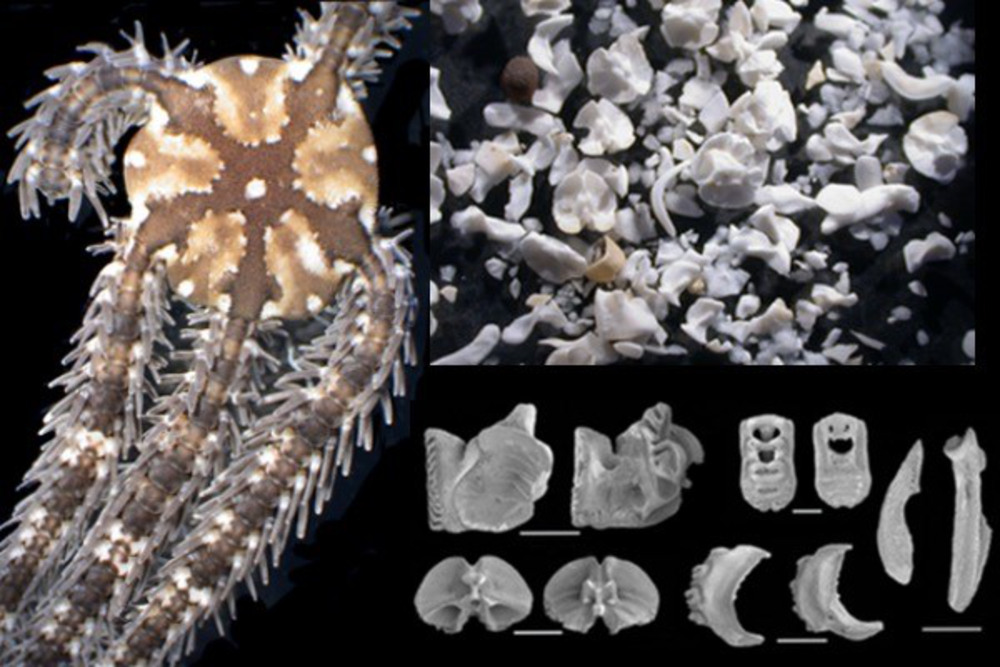Forskningsområden: Zoologi
Forskningsämnen: Echinodermer, Taxonomi & artbeskrivning, Evolution
Innehållsförteckning
Forskningsområden: Zoologi
Forskningsämnen: Echinodermer, Taxonomi & artbeskrivning, Evolution
Project overview
Project period: 2000–2027
Participating departments from the museum: ZOO
This multi-disciplinary project aims to understand the evolutionary history of the modern brittle stars (Ophiuroidea), the most speciose class of echinoderms (Echinodermata), which originated over 400 million years ago. After the evolutionary bottleneck of the Permian-Triassic mass extinction, 250 million years ago, the surviving lineages underwent fast radiation, filling many empty ecological niches, to form the modern-day crown group with about 2100 living species.
The phylogenetic relationships within this group were long misunderstood due to difficulties with analyzing synapomorphies, and earlier limitations in molecular methods.
The main approach of this study is morphological to allow utilization of the rich fossil record, which consists of mainly dissociated skeletal elements. We also collaborate with geneticists.
A better understanding of the phenotype is needed to explore how genes create morphologies. We examine skeletal elements with scanning electron microscopy, and most recently, with x-ray micro-computed tomography. The project will build up a large dataset of high resolution digital images of micromorphological structures in 2D and 3D.
Our main target has been the skeleton of the arms, which has recently been discovered to be particularly rich in phylogenetically informative characters. Currently, we focus on specific skeletal elements in the main body disc. We are also studying the effect of evolutionary mechanisms such as heterochrony, and trace the evolution of particular structures through time, compared to adaptation by selection acting on existing structures.
This research is a long-term effort with wide international collaboration.
Funding
Riksmusei Vänner External link, opens in new window. and the Swedish Museum of Natural History
External link, opens in new window. and the Swedish Museum of Natural History
Select Publications
- Goharimanesh, M., Ghassemzadeh, F., De Kegel, B., Van Hoorebeke, L., Stöhr, S., Mirshamsi, O., Adriaens, D., 2022. The evolutionary relationship between arm vertebrae shape and ecological lifestyle in brittle stars (Echinodermata: Ophiuroidea). Journal of Anatomy 240, 1034–1047. https://doi.org/10.1111/joa.13617
- Stöhr, S., Clark, E.G., Thuy, B., Darroch, S. a. F., 2019. Comparison of 2D SEM imaging with 3D micro-tomographic imaging for phylogenetic inference in brittle stars (Echinodermata: Ophiuroidea). Zoosymposia 15, 146–158. https://doi.org/10.11646/zoosymposia.15.1.17
- Stöhr, S., O’Hara, T.D., 2021. Deep-sea Ophiuroidea (Echinodermata) from the Danish Galathea II Expedition, 1950–52, with taxonomic revisions. Zootaxa 4963, 505–529. https://doi.org/10.11646/zootaxa.4963.3.6
- Stöhr, S., Weber, A.A.-T., Boissin, E., Chenuil, A., 2020. Resolving the Ophioderma longicauda (Echinodermata: Ophiuroidea) cryptic species complex: five sisters, three of them new – Corrigendum. European Journal of Taxonomy 600, 1-37. https://doi.org/10.5852/ejt.2020.607
Project members
External participants
- Natural History Museum, Luxemburg City, Luxemburg
- Museum Victoria, Melbourne, Australia
Project manager


